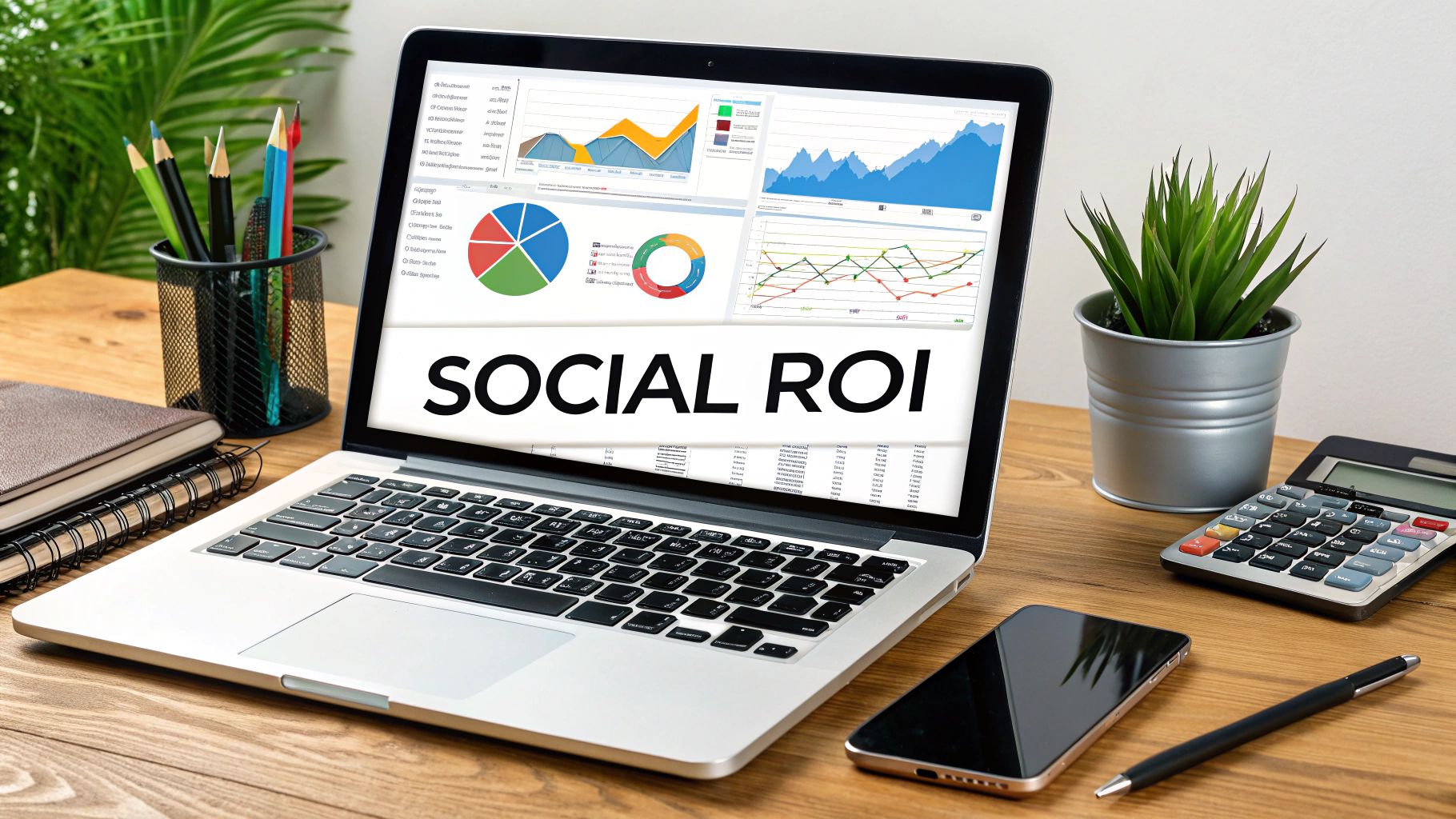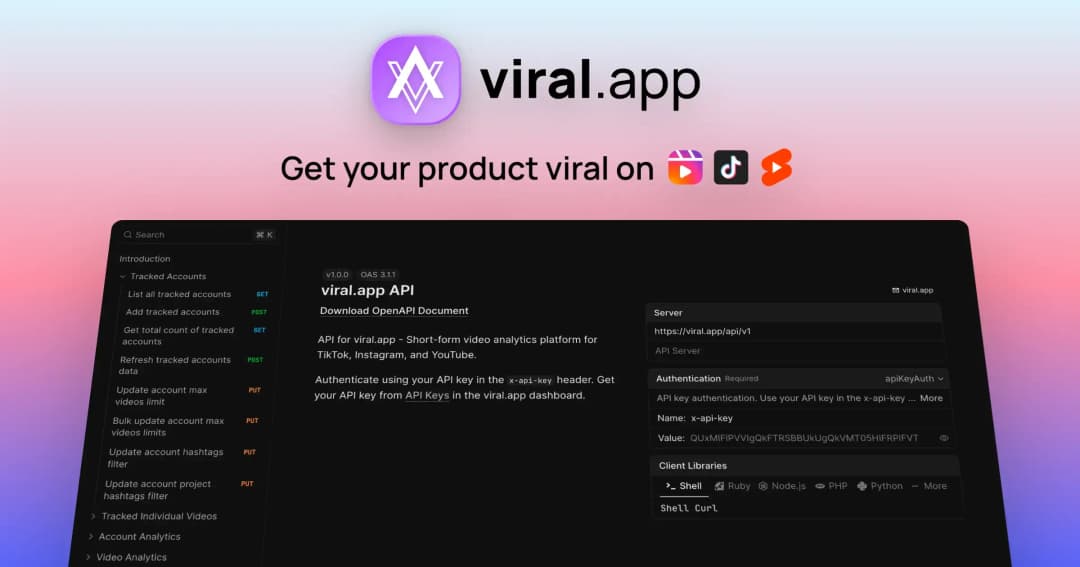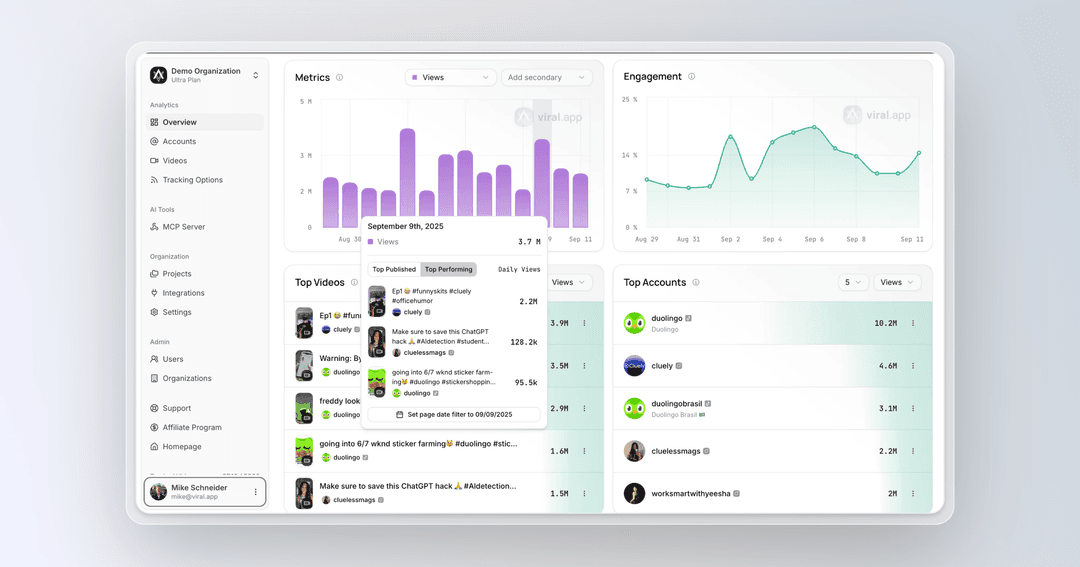Questions & Answers
We're here to help you get the most out of viral.app.
Move beyond vanity metrics. Learn to track, calculate, and prove the real financial impact of your social media strategy.

Measuring your social media ROI is really just about figuring out if the money you're spending is actually making you more money back.
The simple math is (Profit / Total Investment) x 100. Your profit is the revenue you can directly tie to your social campaigns, and the investment is everything you put in—ad spend, tools like viral.app, and the cost of your team's time. This number is your key to proving the real financial impact of your social strategy.
Let's be honest, staring at a dashboard full of likes and new followers feels good. But those numbers don't pay the bills. The pressure is on for marketers to connect the dots between a viral video and actual business outcomes, like sales and leads. It's no longer enough to just report on engagement; leadership wants to see quantifiable results.
This creates a real disconnect between what executives expect and what many marketers feel equipped to deliver. Measuring social media ROI isn't just about justifying your budget anymore. It's about making smarter, data-driven decisions that fuel genuine growth. This requires tracking the right engagement metrics and using professional reporting templates. The conversation has to shift from "look how many people liked our post" to "look how much revenue that post generated."
This push for clear, financial justification isn't just a fleeting trend—it's the new standard. According to the 2025 Sprout Social Index™, a staggering 65% of marketing leaders want to see a direct line from social media campaigns to the company's biggest goals. On top of that, 52% are looking for real, quantifiable cost savings from their social channels. You can dive deeper into these social media marketing ROI statistics in their full report.
This intense focus on accountability shines a light on a huge challenge in our industry.
Even though 97% of leaders believe they can explain social media’s value, only 30% of marketers feel they can actually measure it effectively. Closing this confidence gap is exactly what we’re here to do.
Metrics like follower counts, likes, and impressions are often called vanity metrics, and for good reason. They can give you a rough pulse on brand health and audience size, but they rarely tell you anything about revenue or profit. A post can go viral with millions of views and not lead to a single sale, making it a terrible yardstick for business success.
Focusing only on these surface-level numbers can cause some serious problems:
The real goal is to build a measurement framework that tells the whole story—one that connects the dots from a TikTok video or Instagram Reel all the way to a customer's credit card swipe.
Look, before you can measure anything, you have to know what winning actually looks like. Trying to calculate social media ROI without specific goals is like starting a road trip with no destination in mind. You’ll just burn through your budget without getting anywhere useful.
The entire foundation of a solid measurement strategy is moving past fuzzy ideas like "more engagement" or "brand awareness." You've got to connect your social media efforts directly to real business objectives. This is the first, most critical step—it’s what turns your ROI calculation from a guess into a sharp, undeniable number.
Every single social campaign you run needs to support a bigger company priority. So, your first move is to figure out what those priorities are. Get in a room with the leadership team and ask the important questions. You need to make sure your social strategy is perfectly in sync with what the C-suite actually cares about.
I've found these questions really help get the clarity you need:
When you get these answers upfront, the goals you set for social media will actually mean something to key stakeholders. This is how you shift the conversation about social from being a "cost center" to a vital part of the company's growth.
Once you know the high-level business objectives, you can start breaking them down into concrete, actionable social media goals. This is where it gets real. A powerful goal isn't just a wish—it's a precise target with a firm deadline.
Let's walk through a few real-world examples:
The main takeaway here is simple: you can't effectively measure what you haven't clearly defined. Specific targets give you a yardstick to measure against. Every tweet, post, and video becomes a deliberate step toward a quantifiable result.
This whole process also forces you to think strategically about which platforms and tactics will actually serve your objectives. If your goal is generating high-quality B2B leads, you're probably better off spending your time on LinkedIn, not TikTok. Aligning your goals with your strategy from day one is the most important thing you can do to prove your social media ROI.
With your goals locked in, it's time to get surgical about the data you track. It's incredibly easy to drown in a sea of social media analytics, but let's be honest—most of it is just noise. Vanity metrics like impressions and follower counts might look good on paper, but they won't tell you if your strategy is actually working.
To truly measure social media ROI, you have to focus on the Key Performance Indicators (KPIs) that tell a financial story. These are the numbers that give you real, actionable insights and get your leadership team to lean in. It’s how you shift the conversation from "look at all this activity" to "look at the impact we're making."
Vanity metrics are the fool's gold of social media. They look shiny and impressive but have no real connection to business outcomes. A post that gets a million views but drives zero sales isn't a win; it's a wasted investment.
Value metrics, on the other hand, tie directly back to the goals we just talked about. These are the numbers that prove social media is driving tangible results—generating leads, boosting sales, or improving customer loyalty. The trick is learning to spot what looks good versus what is good for the bottom line.
To get there, you have to align every KPI with a concrete business result. The days of justifying your budget with likes and follower growth are long gone. Today, it’s all about click-through rates, conversion rates, and cost per acquisition. In fact, a whopping 77% of marketers now say that proving ROI is more critical than it was just two years ago. This isn't a trend; it's a fundamental shift in how we measure success.
Now, let's build the bridge between your big-picture business objectives and the specific metrics you’ll track on social media. This framework is your secret weapon, ensuring every data point you report has a clear, strategic purpose.
Imagine your main goal is to increase online sales. Your social KPIs need to revolve entirely around conversions.
But what if your goal is generating qualified leads for the sales team? The metrics shift completely.
The most powerful thing you can do is tie every metric back to a dollar value. A lead isn't just a name and an email; it's a potential source of future revenue. By assigning a value to each lead, you can start speaking the financial language that leadership understands.
This table shows how to connect high-level goals to the right KPIs, moving you beyond surface-level stats.
| Business Goal | Primary Social Media KPI | Supporting Metrics |
|---|---|---|
| Increase Online Sales | Conversion Rate | Cost Per Acquisition (CPA), Average Order Value (AOV), Revenue per Click (RPC) |
| Generate Qualified Leads | Cost Per Lead (CPL) | Leads Generated, Lead-to-Customer Rate, Form Completion Rate |
| Boost Brand Awareness | Share of Voice | Reach, Engagement Rate, Follower Growth (contextualized), Video Views |
| Improve Customer Loyalty | Customer Lifetime Value (CLV) | Repeat Purchase Rate, Net Promoter Score (NPS), Positive Mentions |
| Drive Website Traffic | Click-Through Rate (CTR) | Cost Per Click (CPC), Unique Visitors from Social, Bounce Rate |
By creating this clear map, you're not just tracking data; you're building a compelling case for your team's value. When it's time to present your findings, a structured approach makes all the difference. Using a social media analytics report template can help you organize this information into a story that’s clear, convincing, and impossible to ignore.
Let's be honest, the biggest headache in social media marketing is proving your work leads to actual sales. You can create the most viral Reel in the world, but if you can't connect that view to a new customer, you're flying blind. It's time to stop guessing and start tracking.
This is where we get a little technical, but I promise it's worth it. We're going to connect the dots and show you how to prove that a specific TikTok video or Instagram Story directly resulted in a purchase or a lead.
One of the simplest yet most powerful tools in your arsenal is the Urchin Tracking Module (UTM) parameter. Don't let the name scare you. These are just small bits of text you add to the end of a URL that act like digital breadcrumbs, telling your analytics tools exactly where someone came from.
When a user clicks a link tagged with UTMs, that information gets passed straight to your Google Analytics account. Instead of seeing a generic source like "social," you'll know the click came from your summer-sale-2025 campaign, specifically from an instagram story. This is a total game-changer for measuring social media ROI.
A solid UTM link just needs three key parts:
utm_source: The platform the click came from (e.g., instagram, tiktok, linkedin).utm_medium: The type of marketing channel (e.g., social, cpc, influencer).utm_campaign: The specific campaign name (e.g., q3-product-launch, summer-sale-2025).Using these consistently turns your messy traffic data into a clear story about what's driving results.
UTMs are fantastic for tracking direct clicks, but they don't tell the whole story. What about the user who saw your ad on their feed, didn't click, but remembered your brand and bought something a week later? That's where platform-native tools like the Meta Pixel and LinkedIn Insight Tag come in.
These are tiny snippets of code you install on your website. They track what users do after they’ve seen your content on social media, even if they never clicked the link.
I see this all the time: a user sees an Instagram ad for a cool product, gets distracted, but later Googles the brand and makes a purchase. Without the Meta Pixel, that conversion would look like it came from organic search. The pixel helps you track these view-through conversions, giving you credit where it's due.
This is how you start to understand the true influence of your social media efforts.
At the end of the day, it all comes back to this simple calculation. The tools we've discussed are what allow you to accurately measure the "Revenue" part of the equation.
These platform-specific trackers capture conversions that would otherwise be invisible, giving you a much richer dataset for your ROI calculations. To really get a complete picture, it's worth exploring advanced models like Cross-Channel Attribution. This helps you see how all your marketing channels work together to guide a customer toward a final purchase.

Alright, you've defined your goals and you're tracking the right data. Now comes the moment of truth: putting it all together to figure out your return on investment.
The basic social media ROI formula is simple enough: (Profit / Total Investment) x 100. But where most people go wrong is in how they calculate those two key numbers. It's about getting an accurate, holistic view of both sides of the equation.
For profit, it’s a mistake to only look at direct sales. Think bigger. You have to consider the lifetime value of the customers you've brought in. A customer who makes a $50 purchase today could easily be worth $500 over the next year, and that completely changes the ROI picture.
Your investment is much more than just what you spent on ads. To get a real, defensible number that your finance team will take seriously, you need to account for every single resource sunk into your social media efforts.
A full accounting of your investment should include:
Once you have your true profit and your total investment, the math is straightforward. Let's say a campaign generated $10,000 in value and cost $2,500 in total investment. That's a 300% ROI. Now that's a number that gets people's attention.
Data without a story is just a spreadsheet. The final, most crucial step is to weave your numbers into a compelling narrative that demonstrates strategic value and justifies future budget requests.
This means you can't just present the "what." You have to explain the "why" and detail what you're going to do next. For instance, the ROI of an influencer campaign isn't just about sales; it's about the trust and authority your brand built. We break this down even further in our guide on the ROI of influencer marketing.
If you want to go even deeper and really nail down your measurement process, check out this a comprehensive guide on measuring social media ROI. It's a fantastic resource for refining your entire approach.
Even with a solid game plan, measuring your social media ROI can feel like you're hitting a wall. It’s completely normal to run into a few tricky questions when you start trying to connect social activities to hard numbers.
Let's walk through some of the most common challenges I see marketers face and break down how to solve them.
One of the biggest struggles is proving the value of top-of-funnel goals, like brand awareness. It feels abstract, but you can absolutely demonstrate its impact without tying a direct dollar sign to every single post.
When your goal is brand awareness, you're playing the long game. You need to focus on proxy metrics—the numbers that show your influence and reach are growing over time. Think of it as building momentum.
You won't get a neat ROI percentage right away, but consistent growth in these areas is a powerful signal of future value.
Keep a close eye on these key metrics:
Showing a steady upward trend in these metrics proves your top-of-funnel work is making your brand more discoverable and recognizable. And that, in turn, feeds your entire sales funnel.
A huge myth I see everywhere is that going viral automatically means a high ROI. The truth is, virality doesn't always translate to meaningful engagement with the right audience. It's far more valuable to focus on solving your audience's problems than chasing viral hits that miss the mark on your business goals.
This is a step people often skip, and it completely skews the numbers. If you ignore labor costs, your ROI calculation will be artificially high and, frankly, not very credible.
To get an accurate picture of your true investment, you absolutely must factor in your team's time.
Start by calculating a rough hourly rate for each person involved in your social campaigns (don't forget to include salary and benefits). Use a time-tracking tool or just make an honest estimate of the hours they pour into a specific campaign.
Multiply the hours spent by each person's hourly rate, and you've got your total labor cost. Add this number to your ad spend and tool subscriptions, and now you have a complete, defensible view of your total investment. This is the kind of detail you need for accurate social media campaign reporting and for having productive conversations with your finance team.
Ready to stop guessing and start proving the value of your video content? viral.app gives you the powerful tracking and analytics you need to measure the true ROI of your campaigns on TikTok, Instagram Reels, and YouTube Shorts. Get started with viral.app today!
We're here to help you get the most out of viral.app.
Become an expert in UGC marketing today leveraging our industry knowledge and unique tools.

Build custom workflows and integrations with programmatic access to your analytics

Track how single videos go viral with detailed performance insights and daily top performer breakdowns

UGC-Marketing with the ultimate growth-pilot.